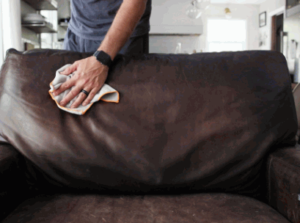If you’ve ever noticed mold growing on your leather couch, you may be wondering what caused it and how to get rid of it.
We explore the common causes of mold on leather couches, how to identify it, and whether it poses any dangers.
We’ll also guide you through the steps to effectively clean mold out of your leather couch and provide tips on preventing future growth.
Keep reading to learn how to keep your leather couch looking its best!
Learn more: What’s The Best Way To Clean Leather Upholstery
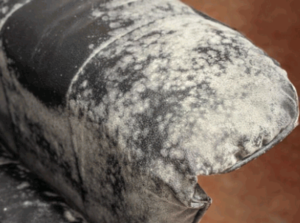
What Causes Mold On Leather Couches?
Mold on leather couches is a common furniture problem caused by a combination of high humidity levels, poor ventilation, and the presence of mold spores, which can lead to mold growth on the leather surface and pose significant health risks.
Moisture And Humidity
High humidity levels are one of the primary causes of mold growth on leather surfaces, as moisture provides an ideal environment for mold spores to thrive.
Ensuring proper ventilation and humidity control in areas where leather goods are stored or exhibited is crucial to prevent mold formation.
- Controlling humidity levels can significantly reduce the risk of mold growth, as mold spores require moisture to germinate and proliferate.
- This is where a dehumidifier plays a vital role. By removing excess moisture from the air, a dehumidifier helps maintain optimal humidity levels, thus inhibiting mold growth on leather surfaces.
Poor Ventilation
Poor ventilation significantly contributes to mold growth on a leather couch by trapping moisture and reducing air circulation, which creates a perfect breeding ground for mold spores.
Proper ventilation is crucial in maintaining the longevity and quality of your leather furniture. When air cannot circulate effectively, it leads to the accumulation of moisture, making it an ideal environment for mold to thrive.
To prevent mold growth on your leather couch, consider placing it in a well-ventilated area where air can freely move around. Opening windows and using fans can help improve airflow and reduce humidity levels in the room.
Regularly inspect your leather furniture for any signs of mold and address them promptly. Proper ventilation not only protects your furniture but also creates a healthier living environment for you and your family.
Spills And Stains
Spills and stains on a leather couch, if not promptly cleaned, can lead to mold growth by providing a source of nutrients and moisture for mold spores.
It is imperative to address any spills and stains on a leather couch immediately to prevent the onset of mold. Mold thrives in damp environments, and the organic matter in spills can serve as sustenance for its growth. To tackle this issue effectively, it is recommended to use gentle cleaning solutions specifically formulated for leather upholstery. Avoid harsh chemicals that may damage the material and opt for mild cleaners to preserve the quality of the leather while eliminating the stain. Regular maintenance and quick action are key in preventing mold from spreading and safeguarding the longevity of your leather furniture.
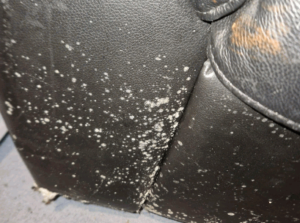
How To Identify Mold On A Leather Couch?
Identifying mold on a leather couch typically involves looking for visible signs of mold spores, such as green or black patches, musty odors, and changes in the texture or color of the leather surface.
Mold on leather can sometimes appear as fuzzy growths or powdery substances scattered across the material. These colonies can spread rapidly if not addressed promptly, potentially causing irreversible damage to the leather.
To inspect for mold on a leather couch, use a flashlight to check hidden areas like crevices, seams, and beneath cushions. Run your fingers along the surface to feel for any irregularities or soft spots, which could indicate mold growth beneath the surface.
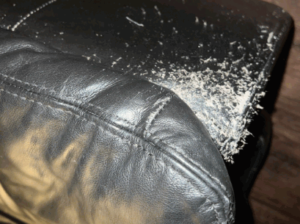
Is Mold On A Leather Couch Dangerous?
Mold on a leather couch can be dangerous as it poses significant health risks, including respiratory issues and allergic reactions, due to the release of mold spores and mildew into the air.
Exposure to mold in indoor environments can exacerbate existing respiratory conditions such as asthma and lead to persistent coughing, wheezing, and throat irritation. Plus respiratory problems and prolonged contact with mold can trigger skin rashes, redness, and itching in sensitive individuals.
Mold exposure has been linked to headaches, fatigue, and difficulty concentrating, affecting both physical and cognitive well-being. Identifying signs of mold growth, such as musty odors, damp spots, or visible discoloration on surfaces, is crucial to prevent health complications.
How To Clean Mold Out Of A Leather Couch
Cleaning mold out of a leather couch involves a systematic process, starting with preparing a cleaning solution, vacuuming the couch, testing the solution on a small area, applying it to the affected areas, rinsing and drying the couch, and finally using a leather conditioner to restore its appearance.
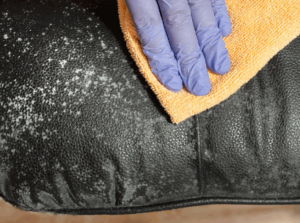
Prepare The Cleaning Solution
To prepare the cleaning solution, mix equal parts water and vinegar, or opt for a mixture of mild soap and water, which are both effective in killing mold spores without damaging the leather.
In the water and vinegar solution, the acidity of vinegar helps to break down mold and mildew while the water dilutes it, making it safe to use on leather surfaces. On the other hand, mild soap combined with water works by suffocating the mold spores and then removing them from the leather surface upon wiping.
Both these mixtures are gentle yet powerful in combating mold growth, making them ideal choices for maintaining the quality and appearance of leather items. It is important to ensure thorough cleaning and drying after application for optimal results.
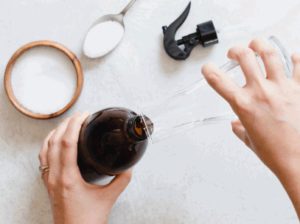
Vacuum The Couch
Vacuum the leather couch using a soft brush attachment to remove loose mold spores and debris, ensuring that you cover all areas thoroughly.
Removing mold spores from the leather couch is crucial to prevent them from spreading and potentially causing health issues or further damage to the furniture. Mold spores can easily become airborne and circulate in your indoor environment if not properly dealt with.
When using the vacuum, it’s important to be gentle to avoid damaging the delicate leather. Make sure to move in slow, deliberate motions and avoid using excessive force.
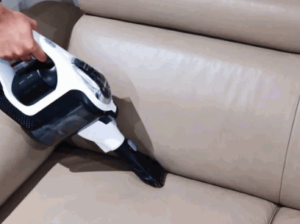
Test The Cleaning Solution On A Small Area
Before applying the cleaning solution to the entire leather surface, test it on a small, inconspicuous area to ensure that it does not discolor or damage the leather.
Testing the cleaning solution beforehand is a crucial step in leather care. This precaution can prevent potential harm to the leather surface and maintain its pristine condition.
To perform the test, choose a hidden spot or a small corner of the leather item. Apply a small amount of the cleaning solution on a soft cloth and gently rub it onto the selected area. Allow it to dry completely and then assess the results. Look for any changes in color, texture, or appearance. If there are no adverse effects, you can proceed with cleaning the rest of the leather using the tested solution.
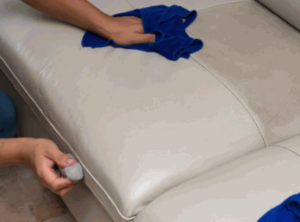
Apply The Cleaning Solution To The Affected Areas
Apply the cleaning solution to the affected areas using a soft cloth, gently rubbing in circular motions to lift and remove the mold.
Be careful not to apply too much pressure as leather is sensitive to abrasion. The gentle circular motions help break down the mold without causing any damage to the leather surface. It is essential to allow the solution to sit for a few minutes before wiping it off with a clean, damp cloth.
Thoroughly inspect all seams and crevices to ensure complete mold removal.
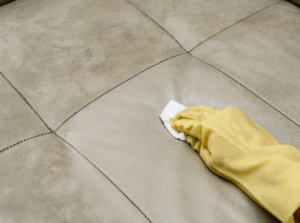
Rinse And Dry The Couch
After cleaning, rinse the couch with a damp cloth to remove any remaining cleaning solution, and then dry it thoroughly using a dry, soft cloth to prevent any residual moisture from promoting mold regrowth.
Once you have finished rinsing the couch, it is crucial to ensure that it is dried properly to maintain its integrity and prevent any potential damage. To speed up the drying process, consider using fans to create airflow around the couch. Positioning fans strategically can help evaporate the moisture more quickly.
Another effective method to expedite drying is by placing the couch in direct sunlight. The sun’s natural warmth and light can aid in drying out any remaining moisture within the fabric. Remember to periodically flip the cushions to allow for even drying.
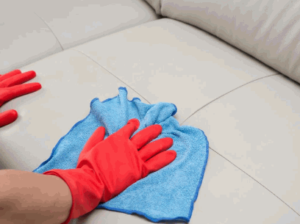
Use A Leather Conditioner To Restore The Couch
After the cleaning process, apply a leather conditioner to the couch to restore the leather surface, keeping it supple and preventing future damage.
Using a leather conditioner not only helps maintain the integrity of the leather but also adds a layer of protection against wear and tear, UV damage, and spills. A good quality conditioner nourishes the leather, keeping it from drying out and cracking over time, enhancing its longevity.
When choosing a leather conditioner, opt for products specifically designed for the type of leather on your couch to ensure compatibility and optimal results.
For application, start by testing the conditioner on a small, inconspicuous area of the couch to check for any adverse reactions. Then, using a clean cloth or applicator, apply the conditioner in gentle, circular motions, allowing it to penetrate the leather. Buff off any excess conditioner to achieve a smooth, conditioned finish.
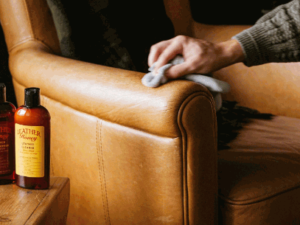
How To Prevent Mold From Growing On A Leather Couch?
Preventing mold from growing on a leather couch involves implementing effective preventive measures, such as maintaining low humidity levels, ensuring proper ventilation, and adopting regular cleaning practices to keep the couch dry and mold-free.
Keep The Couch Clean And Dry
Regularly cleaning and drying your leather couch is a fundamental preventive measure to keep mold at bay, as it removes potential food sources and moisture that could promote mold growth.
Aside from preventing mold, routine cleaning practices also enhance the overall appearance and longevity of your couch.
Immediate action on spills and stains is crucial to prevent them from setting and becoming harder to remove. Using a mild soap or specific leather cleaner, gently wiping the affected area with a clean, damp cloth can help lift stains effectively. Make sure to completely dry the spot afterward to avoid any water stains or further damage to the leather.
Use A Dehumidifier In Humid Environments
Using a dehumidifier in humid environments is an effective way to prevent mold growth by maintaining optimal humidity levels and reducing excess moisture in the air.
Dehumidifiers work by drawing in damp air, which then passes over cold coils that condense the moisture into water droplets. These droplets are collected in a reservoir or drained out through a hose.
The benefits of using a dehumidifier extend beyond mold prevention. They also help alleviate allergies, improve air quality, and create a more comfortable living environment.
When choosing the right dehumidifier for your living space, consider factors like room size, desired humidity levels, and whether you need a portable or whole-house unit.
Avoid Spills And Stains
Avoiding spills and stains on your leather couch can significantly reduce the risk of mold growth, as these can create moist areas that favor mold development.
One effective way to protect your couch is by using protective covers. These covers not only shield your couch from spills but also add a layer of defense against everyday wear and tear. Additionally, being mindful of food and drinks around the leather furniture can go a long way in maintaining its pristine condition. Consider setting up designated areas for eating and drinking, away from the couch, to minimize the chances of accidents. By following these simple tips, you can keep your leather couch looking great for years to come.
